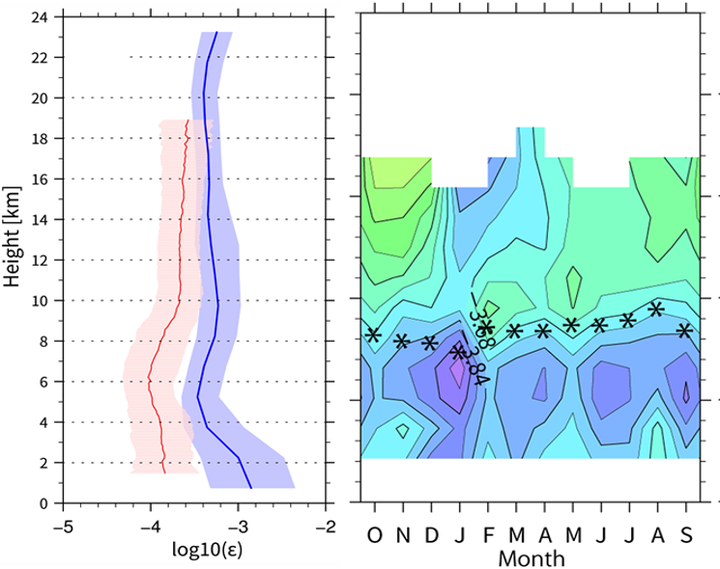Estimate of Turbulent Energy Dissipation Rate From the VHF Radar and Radiosonde Observations in the Antarctic
 (Left) Vertical profiles of energy dissipation rates from (red) the PANSY radar and (blue) radiosondes. (Right) A time-height section of energy dissipation rates from the PANSY radar. Adapted from Kohma et al. (2019).
(Left) Vertical profiles of energy dissipation rates from (red) the PANSY radar and (blue) radiosondes. (Right) A time-height section of energy dissipation rates from the PANSY radar. Adapted from Kohma et al. (2019).要旨
This study estimated the turbulent kinetic energy dissipation rates (TKEDRs) from 1‐year observations of the Program of the Antarctic Syowa Mesosphere‐Stratosphere‐Troposphere/Incoherent Scatter radar (PANSY radar) from October 2015 to September 2016 and compared the results with estimates from radiosonde measurements based on Thorpe’s method. The radar‐based estimates showed that the TKEDR at Syowa Station was on the order of 10−5–10−3 m2/s3 in the altitude range of 1.5–19 km. Taking the proportional constant for Thorpe’s method (the ratio of the Thorpe scale to Ozmidov scale) as unity, the radiosonde‐based measurements show values of TKEDR larger than radar‐based estimates by a factor of 2–5. The difference in the TKEDR between radiosonde‐ and radar‐based estimates is larger in the middle and upper troposphere than in the stratosphere. According to previous observational and numerical studies, Thorpe’s method tends to overestimate the TKEDR for deep overturning layers. It is confirmed that the depth of the overturning layer is negatively correlated with the difference between radiosonde‐ and radar‐based estimates. The seasonal variation was also examined. An analysis using the distance from the local tropopause level showed that the local maximum in the TKEDR around the tropopause is particularly clear in austral summer. This is likely connected to the seasonality in the gravity wave activity in the Antarctic stratosphere.